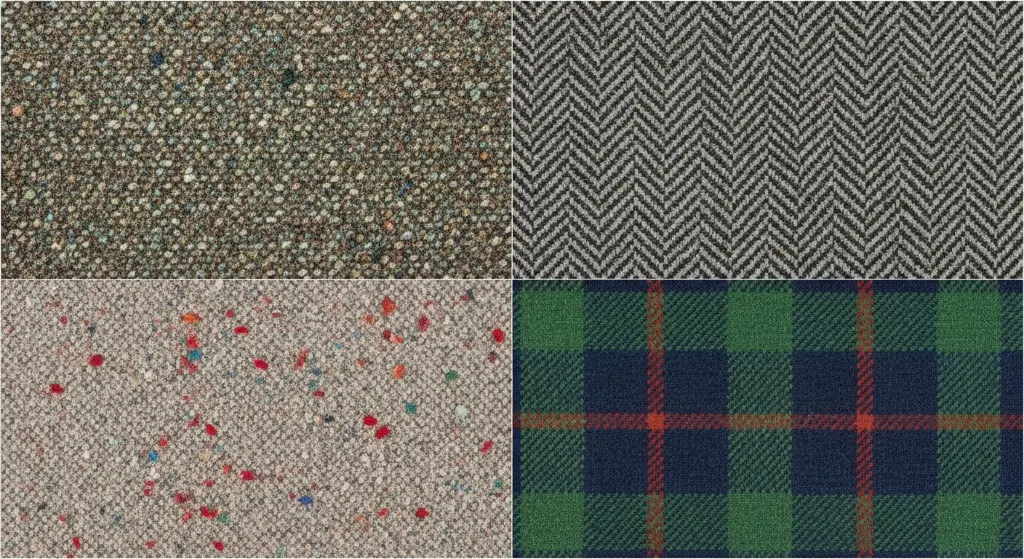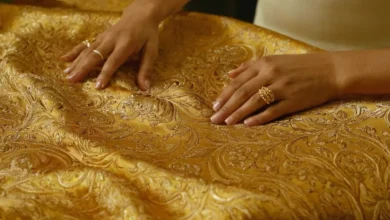Discover why tweed is the quintessential fabric of the British countryside. From the rugged shores of the Outer Hebrides to the rolling hills of the Borders, explore the history and enduring appeal of Harris Tweed, Donegal Tweed, and iconic patterns.
A Story of Fabric, Function, and Heritage
Picture the British countryside. What do you see?
Perhaps it’s a windswept moor in Scotland, a misty morning in the Yorkshire Dales, or a gentleman walking his dog along a country lane in the Cotswolds. And what is he wearing? Almost certainly, it’s a tweed jacket.
No fabric is more deeply woven into the identity and landscape of the British Isles than tweed. It is more than just a textile; it is a story of place, a shield against the elements, and a symbol of an enduring, understated style. From the peaty rivers of the Outer Hebrides to the grand country estates, tweed is the unofficial uniform of the British countryside.
See also Day of the Dead: A Vibrant Celebration of Life, Love, and Remembrance 🎊💀🌸
Day of the Dead: A Vibrant Celebration of Life, Love, and Remembrance 🎊💀🌸
But how did this coarse, rustic wool cloth become such an icon of sartorial heritage?
In this article, we will unravel the threads of history and explore:
✅ The rugged origins of tweed in Scotland and Ireland.
✅ The different types of tweed, from the world-renowned Harris Tweed to the colorful Donegal Tweed.
✅ The iconic tweed patterns that mimic the natural landscape.
✅ Why the tweed jacket became a staple of country life and classic menswear.
✅ The enduring legacy of this remarkable tweed fabric.
Grab a cup of tea, settle in, and let’s journey into the heart of a fabric born of the land itself.
🐑 The Origins of Tweed: A Fabric Born from the Landscape
The story of tweed begins not in a fashion house, but on the windswept, rugged landscapes of Scotland and Ireland in the 18th century. Farmers and crofters needed a fabric that could withstand the harsh, damp, and unforgiving climate.
See also Comparing Traditional Festivals in Asian and European Cultures
Comparing Traditional Festivals in Asian and European Cultures
- The Material: They used the wool from their local sheep. This wool was naturally hardy, weather-resistant, and incredibly warm.
- The Weave: Unlike finer worsted wools, tweed fabric is made from woolen yarns that are carded, not combed, resulting in a softer, more open, and slightly “fuzzy” texture. It was woven in a twill structure, which makes it durable and flexible.
- The Name: The name “tweed” is believed to have originated from a happy accident. The original Scottish name for the fabric was tweel (the Scots word for twill). Legend has it that in 1831, a London merchant misread a letter from a Hawick-based firm, mistaking “tweel” for “tweed,” assuming it was named after the River Tweed that flows through the Scottish Borders. The name stuck, and it perfectly captured the fabric’s connection to the natural, river-strewn landscape.
Initially, tweed was the humble, practical cloth of farmers, fishermen, and gamekeepers. It was their armor against the wind and rain.
👑 The Victorian Era: From Rustic Cloth to Aristocratic Staple
The transformation of tweed from a working-class fabric to a symbol of the landed gentry began in the 19th century.
- The “Balmoral” Effect: Queen Victoria and Prince Albert fell in love with the Scottish Highlands, purchasing Balmoral Castle in 1852. Prince Albert designed the unique “Balmoral Tweed,” a grey tweed with flecks of red and blue to mimic the castle’s granite. This sparked a trend among the aristocracy.
- The Estate Tweed: Landowners began commissioning their own “estate tweeds.” Each estate developed a unique pattern and colorway, designed to act as a form of camouflage for hunting and stalking on their specific terrain. The tweed would mimic the colors of the local landscape—the purple of the heather, the brown of the peat, the grey of the rock, the green of the bracken.
- A Uniform of Leisure: The tweed jacket and tweed sporting suits became the uniform for country pursuits like shooting, fishing, and deer stalking. Wearing tweed signified that you were part of the landed class, with the time and resources for leisure.
This is the crucial moment when tweed became inextricably linked with the British countryside—not as a place of work, but as a place of aristocratic recreation.
🏝️ The Legendary Tweeds: Harris, Donegal, and Beyond
While tweed is a general term, several specific types have become world-renowned for their unique character and protected heritage.
Harris Tweed: The King of Tweeds
- What it is: Harris Tweed is the most famous tweed in the world. It is not just a type of fabric; it is a legally protected designation. The Harris Tweed Act of 1993 stipulates that to be called Harris Tweed, a fabric must be: “handwoven by the islanders at their homes in the Outer Hebrides of Scotland, finished in the Outer Hebrides, and made from pure virgin wool dyed and spun in the Outer Hebrides.”
- The Character: It is known for its rich, complex colors. The wool is dyed before it is spun, and different colored strands are blended together, creating a deep, heathered look that is impossible to replicate with machine-dyed yarn. It is a sturdy, weather-resistant, and incredibly durable fabric.
- The Orb Mark: Every piece of genuine Harris Tweed is stamped with the iconic Orb certification mark, your guarantee of authenticity.
Donegal Tweed: The Irish Cousin
- What it is: Originating from County Donegal in Ireland, Donegal Tweed is famous for its distinctive, colorful character.
- The Character: It is a plain-weave tweed, but its hallmark is the small, flecks of brightly colored yarn woven in at irregular intervals. These flecks create a rustic, “neppy” texture that is often described as resembling heather and wildflowers on a moor. While traditional Donegal was handwoven, most today is machine-woven, but it retains its iconic speckled look.
Other Notable Types of Tweed:
- Saxony Tweed: Originally made from the fine wool of Merino sheep from Saxony, Germany. Saxony Tweed is a much softer, smoother, and more luxurious tweed. It has a fine, short nap and is often used for high-end jackets and suits.
- Shetland Tweed: Woven from the wool of sheep from the Shetland Islands. Shetland Tweed is lighter, softer, and more delicate than Harris Tweed, making it very comfortable to wear. It’s known for its natural, undyed shades of brown, grey, and cream.
🎨 A Woven Landscape: Iconic Tweed Patterns
The patterns of tweed are as famous as the fabric itself. Many were designed for camouflage and are inspired by the natural world.

- Plain Twill: The simplest form, with a diagonal weave.
- Herringbone: A classic pattern that resembles the skeleton of a herring fish. It creates a distinctive V-shape.
- Houndstooth (or Dogtooth): A duotone pattern of broken checks, said to resemble the jagged teeth of a hound.
- Barleycorn Tweed: A pattern that creates a weave resembling barley kernels. It has a pebbly, three-dimensional texture and is very informal and rustic.
- Overcheck: A simple check or plaid pattern overlaid on another pattern, such as a plain twill or a houndstooth, adding another layer of color and complexity.
- Estate Check (or Glen Check): Larger, more complex check patterns originally designed for specific country estates.
🧥 The Tweed Jacket: An Enduring Icon of Style
The tweed jacket (or sport coat) is the garment that carried the fabric from the hunting grounds to the city streets and university campuses.
- The Country Gentleman: For much of the 20th century, the tweed jacket was the standard informal daytime wear for the British upper and middle classes. Paired with flannel trousers, a V-neck sweater, and brogues, it was the epitome of relaxed, respectable style.
- The Academic: It also became associated with academia, the “uniform” of a university professor. It conveyed an air of intellectualism, tradition, and a certain charming dishevelment.
- Modern Versatility: Today, the tweed jacket remains incredibly versatile. It can be dressed up with a shirt and tie for a smart casual look, or dressed down with a chunky knit sweater and jeans for a weekend in the country. It is a garment that effortlessly bridges the gap between formal and casual.
Conclusion: A Fabric Woven with Soul
Tweed is synonymous with the British countryside for a simple reason: it is a product of the countryside.
It was born of the need for protection against its harsh weather. Its colors are a direct reflection of its moody and beautiful landscapes—the heather, the bracken, the peat, the stone. Its rise to fame is tied to the aristocratic ideal of the country estate, a place of leisure, sport, and tradition.
To wear a tweed jacket is to wear more than just a piece of clothing. It is to wear a piece of a place. Whether it’s a rugged, handwoven Harris Tweed that smells faintly of the peat smoke from an islander’s cottage, or a soft, speckled Donegal Tweed that evokes an Irish meadow, the fabric carries a story.
In a world of fast, disposable fashion, tweed endures. It is a testament to craftsmanship, durability, and a timeless style rooted not in fleeting trends, but in the enduring beauty of the British landscape itself.



